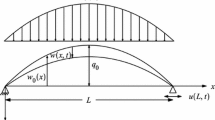Abstract
We pose the problem of self-excitation of elastic wave torsional vibrations of a rotating drill string, which arise as a result of frictional interaction of the drill bit with the rock at the bottom of the deep hole. We use d’Alembert’s solution of the wave equation to construct a mathematical model of the wave torsion pendulum in the form of a nonlinear ordinary differential equation with retarded argument. We show that there exists a range of variation in the angular velocity of the drill string rotation, where, along with the unstable stationary solution characterized by the absence of vibrations, there are oscillatory solutions in the form of a stable limit cycle (attractor). The self-excitation of these vibrations is soft, and the self-oscillations themselves belong to the class of relaxation vibrations, because their period can be divided into several separated intervals corresponding to slow and fast variations in the state of the system. The velocities of the drill bit elastic motions on each of these time intervals remain constant, and the durations of all of them are the same and equal to the time interval (quantum) of the twist mode propagation from the drill bit to the drill string top and conversely.
Similar content being viewed by others
References
A. W. Iyoho, R. A. Meize, K. K. Millheim, and M. J. Crumrine, “Lessons from Integrated Analysis of GOM Drilling Performance,” SPE Dril. Comp. 20(1), 6–16 (2005).
B. Foster, “’Network Diagrams’ Improving the Performance of Well-Drilling with Horizontal Displacement of the Hole Bottom,” Neftegaz. Tekhnol., No. 3, 19–24 (2005).
P. S. Landa, Self-Excited Oscillations in Systems with Finitely Many Degrees of Freedom (Nauka, Moscow, 1980) [in Russian].
M. I. Rabinovich and D. I. Trubetskov, Introduction to the Theory of Vibrations and Waves (Nauka, Moscow, 1984) [in Russian].
B. D. Hassard, N. D. Kazarinov, and Y.-H. Wan, Theory and Application of the Hopf Bifurcation (Cambridge Univ. Press, Cambridge, 1981; Mir, Moscow, 1985).
N. Challamel, “Rock Destruction Effect on the Stability of a Drilling Structure,” J. Sound Vibr. 233(2), 235–254 (2000).
J. Ford Brett, “The Genesis of Torsional Drillstring Vibrations,” SPE Dril. Egngn 7(3), 168–174 (1992).
J. D. Jansen and L. Van den Steen, “Active Damping of Self-Excited Torsional Vibrations in Oil Well Drillstrings,” J. Sound Vibr. 179(4), 647–668 (1995).
R.W. Tucker and C. Wang, “On the Effective Control of Torsional Vibrations in Drilling Systems,” J. Sound Vibr. 224(1), 101–122 (1999).
R. W. Tucker and C. Wang, “An Integrated Model for Drill-String Dynamics,” J. Sound Vibr. 224(1), 123–165 (1999).
Author information
Authors and Affiliations
Corresponding author
Additional information
Original Russian Text © V.I. Gulyaev, O.V. Glushakova, S.N. Khudolii, 2010, published in Izvestiya Akademii Nauk. Mekhanika Tverdogo Tela, 2010, No. 2, pp. 134–147.
About this article
Cite this article
Gulyaev, V.I., Glushakova, O.V. & Khudolii, S.N. Quantized attractors in wave models of torsion vibrations of deep-hole drill strings. Mech. Solids 45, 264–274 (2010). https://doi.org/10.3103/S0025654410020123
Received:
Published:
Issue Date:
DOI: https://doi.org/10.3103/S0025654410020123




